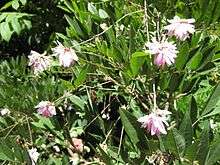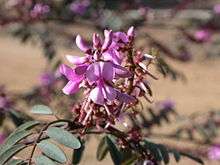Indigofera
| Indigofera | |
|---|---|
 | |
| Indigofera tinctoria | |
| Scientific classification | |
| Kingdom: | Plantae |
| (unranked): | Angiosperms |
| (unranked): | Eudicots |
| (unranked): | Rosids |
| Order: | Fabales |
| Family: | Fabaceae |
| Subfamily: | Faboideae |
| Tribe: | Indigofereae |
| Genus: | Indigofera L. |
| Species | |
|
See text | |
| Wikimedia Commons has media related to Indigofera. |
| Wikispecies has information related to: Indigofera |

_(6379945801).jpg)
_in_Hyderabad%2C_AP_W_IMG_0204.jpg)

Indigofera is a large genus of over 750 species[1] of flowering plants belonging to the family Fabaceae. They are widely distributed throughout the tropical and subtropical regions of the world.[1]
Description
Species of Indigofera are mostly shrubs, though some are small trees or annual or perennial herbs. Most have pinnate leaves. Racemes of flowers grow in the leaf axils. Most species have flowers in hues of red, but there are a few white- and yellow-flowered species. The fruit is a legume pod of varying size and shape.[1]
Indigofera is a varied genus that has shown unique characteristics that make it an interesting candidate as a potential perennial crop. Specifically, there is diverse variation among species with a number of unique characteristics. Some examples of this diversity include differences in pericarp thickness, fruit type, and flowering morphology. The unique characteristics it has displayed include potential for mixed smallholder systems with a least one other species and a resilience that allows for constant nitrogen update despite varying conditions.
Indigofera is a diverse genus that also shows some unique characteristics in its flowering morphology. For example, one unique characteristic of Indigofera is that it demonstrates an open carpel not seen among many species. In addition, it appears that the organ primordial is often formed at deeper layers than other eudicots[2] This variety in flowering morphology including unique characteristics such as an open carpel could have significant implications on its role in an actual perennial polyculture. For example, different flowering morphologies could be artificially selected for in varying directions in order to better fit in different environmental conditions and with different populations of other plants.
The types of fruit produced by different species of Indigofera can also be divided into broad categories that again show great variation. The three basic types of fruit categories can be separated by their curvature including straight, slightly curved, and falcate. In addition, several of the species including I. microcarpa, I. suffruticosa, and I. enneaphylla have shown delayed dehiscent fruits[3] This variety of fruit could again allow for artificial selection that would allow the most abundant and nutritious fruit types and shapes to be selected for.
Another way to categorize Indigofera is by its pericarp thickness. The pericarp can be categorized as type I, type II, and type III with type I having the thinnest pericarp and fewest layers of schlerenchymatous layers and type III having the thickest pericarp and most layers of schlerenchymatous layers. Despite, the previous examples of delayed dehiscent fruits most fruits of this genus show normal explosive dehiscence to disperse seeds [4] Similar to fruit shape, a variety of fruit sizes allows for traits to be selected for that would allow for the thickest and most bountiful fruits especially when paired with fruit shape.
Uses
Indigo dye
Several species, especially Indigofera tinctoria and Indigofera suffruticosa, are used to produce the dye indigo. Scraps of Indigo-dyed fabric likely dyed with plants from the genus Indigofera discovered at Huaca Prieta predate Egyptian indigo-dyed fabrics by more than 1,500 years.[5] Colonial planters in the Caribbean grew indigo and transplanted its cultivation when they settled in the colony of South Carolina and North Carolina where people of the Tuscarora confederacy adopted the dying process for head wraps and clothing. Exports of the crop did not expand until the mid-to late 18th century. When Eliza Lucas Pinckney and enslaved Africans successfully cultivated new strains near Charleston it became the second most important cash crop in the colony (after rice) before the American Revolution. It comprised more than one-third of all exports in value.
The chemical aniline, from which many important dyes are derived, was first synthesized from I. suffruticosa (syn. I. anil, whence the name aniline).
In Indonesia, the Sundanese use Indigofera tinctoria (known locally as tarum or nila) as dye for batik. Marco Polo was the first to report on the preparation of indigo in India. Indigo was quite often used in European easel painting during the Middle Ages.[6][7]
Health and medicine
Several species of this group are used to alleviate pain. The herbs are generally regarded as an analgesic with anti-inflammatory activity, rather than an anodyne.[8] Indigofera articulata (Khedaish in Arabic) was used for toothache, and Indigofera oblongifolia (hasr in Arabic) was used as an anti-inflammatory for insect stings, snakebites, and swellings.[9]
Indigofera suffruticosa and Indigofera aspalthoides have also been used as anti-inflammatories.[10] A patent was granted for use of Indigofera arrecta extract to relieve ulcer pain.[11]
The Maasai people of Kenya use parts of Indigofera brevicalyx and I. swaziensis as toothbrushes.[12]
Diversity
|
|
Ecology
Indigofera species are used as food plants by the larvae of some Lepidoptera species, including the Turnip Moth (Agrotis segetum).
See also
References
- 1 2 3 4 Indigofera. Flora of China.
- ↑ Paulino, J; Groppo, M; Teixeira, S. (2011). "Floral developmental morphology of three Indigofera species (Leguminosae) and its systematic significance within Papilionoideae.". Plant Systematics and Evolution. 292 (3): 165-176. doi:10.1007/s00606-010-0405-z.
- ↑ Leite, V.; Marquiafável, F.; Moraes, D.; Teixeira, S. (2009). "Fruit anatomy of Neotropical species of Indigofera (Leguminosae, Papilionoideae) with functional and taxonomic implications.". The Journal of the Torrey Botanical Society. 136 (2): 203-211. doi:10.3159/08-RA-106.1.
- ↑ Chauhan, V.; Pandey, A. (2014). "Structure and evolution of the pod in Indigofera (Fabaceae) reveals a trend towards small thin indehiscent pods". Botanical Journal of the Linnean Society. 176 (2): 260-276. doi:10.1111/boj.12203.
- ↑ Jeffrey C. Splitstoser, Jan Wouters and Ana Claro (2016). "Early pre-Hispanic use of indigo blue in Peru". Science Advances. 2 (9). American Association for the Advancement of Science.
- ↑ Douma, Michael. "Pigments through the Ages - History - Indigo". Pigments through the Ages.
- ↑ Buchanan, Rita (1999). A Weaver's Garden: Growing Plants for Natural Dyes and Fibers. Courier Corporation. p. 106. ISBN 9780486407128. Retrieved 12 May 2016.
- ↑ "Tico Ethnobotanical Dictionary". Retrieved 2007-06-16.
- ↑ "(syllabus: Duke University)".
- ↑ see references 8–9 in "Antimicrobial Activity of Indigofera suffruticosa".
- ↑ US 6083509 "Phytodrug for management of peptic ulcer and methods of preparing and using same"
- ↑ Bussmann, R. W., et al. (2006). Plant use of the Maasai of Sekenani Valley, Maasai Mara, Kenya. J Ethnobiol Ethnomed 2 22.
- ↑ Indigofera. Germplasm Resources Information Network (GRIN).
- ↑ Indigofera: North American species. USDA PLANTS.
Further reading
- Kumar, P. Indigo Plantations and Science in Colonial India. Cambridge University Press. 2012.
External links
- Indigofera. eFloras Lists.
- Dressler, S.; Schmidt, M. & Zizka, G. (2014). [http://www.africanplants.senckenberg.de/root/index.php?submitForm=true&page_id=77&searchTextMenue=Indigofera&filterRegionIDs[]=6&filterRegionIDs[]=1&filterRegionIDs[]=2&filterRegionIDs[]=3&filterRegionIDs[]=5 "Indigofera"]. African plants – a Photo Guide. Frankfurt/Main: Forschungsinstitut Senckenberg.
